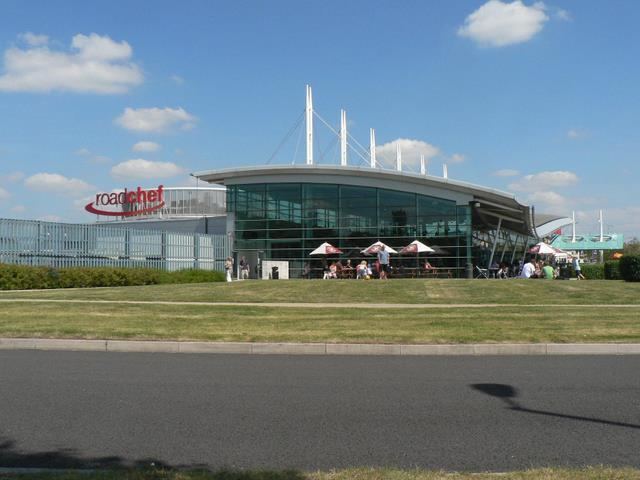 | ||
Motorway service areas in the United Kingdom, also known as 'service stations' or 'services', are places where drivers can leave a motorway to refuel/recharge, rest, eat and drink, shop or stay in an on-site overnight hotel. The vast majority of motorway services in the UK are owned by one of three companies: Moto, Welcome Break and Roadchef. Smaller operators include Extra, Westmorland and EuroGarages.
Contents
History
The first service area in the UK was at Watford Gap on the M1, which opened with the motorway on 2 November 1959. As more service stations opened, the number of operating companies increased, such as Blue Boar, Kenning Motor Group, Pavilion, Take a Break and Esso. Through acquisitions and mergers there are now only four major operators, which has led to concerns about these companies having an oligopoly. In an attempt to break this monopoly, the government proposed allowing "mobile fast food vans" to operate at the areas, though this idea has not come about.
In 2007 an AA survey concluded that service areas had improved in the previous three years, but cleanliness and pricing were still major issues.
Opposition towards service areas has grown, with some planning applications being refused: some notable examples are Catherine de Barnes on the M42 and Kirby Hill on the A1(M), both of which have recently had applications refused. Despite concerns of local residents, Beaconsfield on the M40 opened on 17 March 2009, and Cobham services opened in September 2012.
Locations
Initially service areas were located between junctions (on-line sites), having their own entry and exit slip roads, with a separate site for each direction of travel, though a recent trend has been to locate service areas instead at junction sites: the two most recent openings, Wetherby and Beaconsfield, are examples: they are located at A1(M) junction 46, and M40 junction 2 respectively.
In 1992, the system was changed so that the developer became responsible for choosing the site of a motorway service area, and consequently junction sites became the preferred option as they are cheaper to construct, as well as being accessible to traffic travelling in several directions. Following a public consultation in 2007/8, the Department for Transport/Highways Agency announced that new services should be located at on-line sites, unless a junction site is the only possibility.
The siting of motorway service areas can be contentious, leading to protracted public inquiries, and often vociferous local campaigns against proposed schemes.
Pricing and regulations
Food and fuel sold at motorway services are notoriously expensive. This is often attributed to the many regulations that apply to the areas, and the consequent need to make enough profit from sales to cover the cost of running the service station. The operating company must also pay the full cost of constructing the entry and exit slip roads and all other features required for safe access to motorway services, as well as the motorway services facility itself. In other countries, the authority responsible for the highway tends to subsidise these costs on the grounds that these areas are partly a public service to drivers. The leases provide that motorway services must operate 24 hours a day, and the costs of providing utilities and services are high. With very few customers in the early morning, they need to earn the money in other ways.
Under the terms of the leases, motorway services must provide free short-term parking (2 hours), free 24-hour toilet facilities, and adequate provision for the sale of food and fuel 24 hours a day.
Ireland
Ireland has four motorway service areas – initially the National Roads Authority opposed them on the grounds that it preferred to see traffic using existing businesses in bypassed towns, and that the motorway network was not large enough for them anyway. However, in 2006 it changed its mind, and the Roads Act 2007 makes provision for a Motorway Service Area Scheme to be made for proposed motorway service areas. The NRA held a competition to determine an operator for the first round of service areas to be opened. Superstop, a consortium consisting of Petrogas (Applegreen) and Tedcastles Oil Products (TOP), won the contract. The first service area, Lusk services, opened on the M1 on 8 September 2010. Castlebellingham services (also on the M1) opened on 29 September 2010, with Enfield services on the M4 opening shortly after in late 2010. The fourth service area, Wicklow services station (J14, M11) opened on 29 May 2014. While other locations for service areas were planned by the NRA, they are unlikely to proceed in the short term due to the economic recession. "No services on motorway" signs have been erected on the M7, M8, and M9. The NRA has stated that it now intends to erect signs to petrol stations off the motorway instead.
